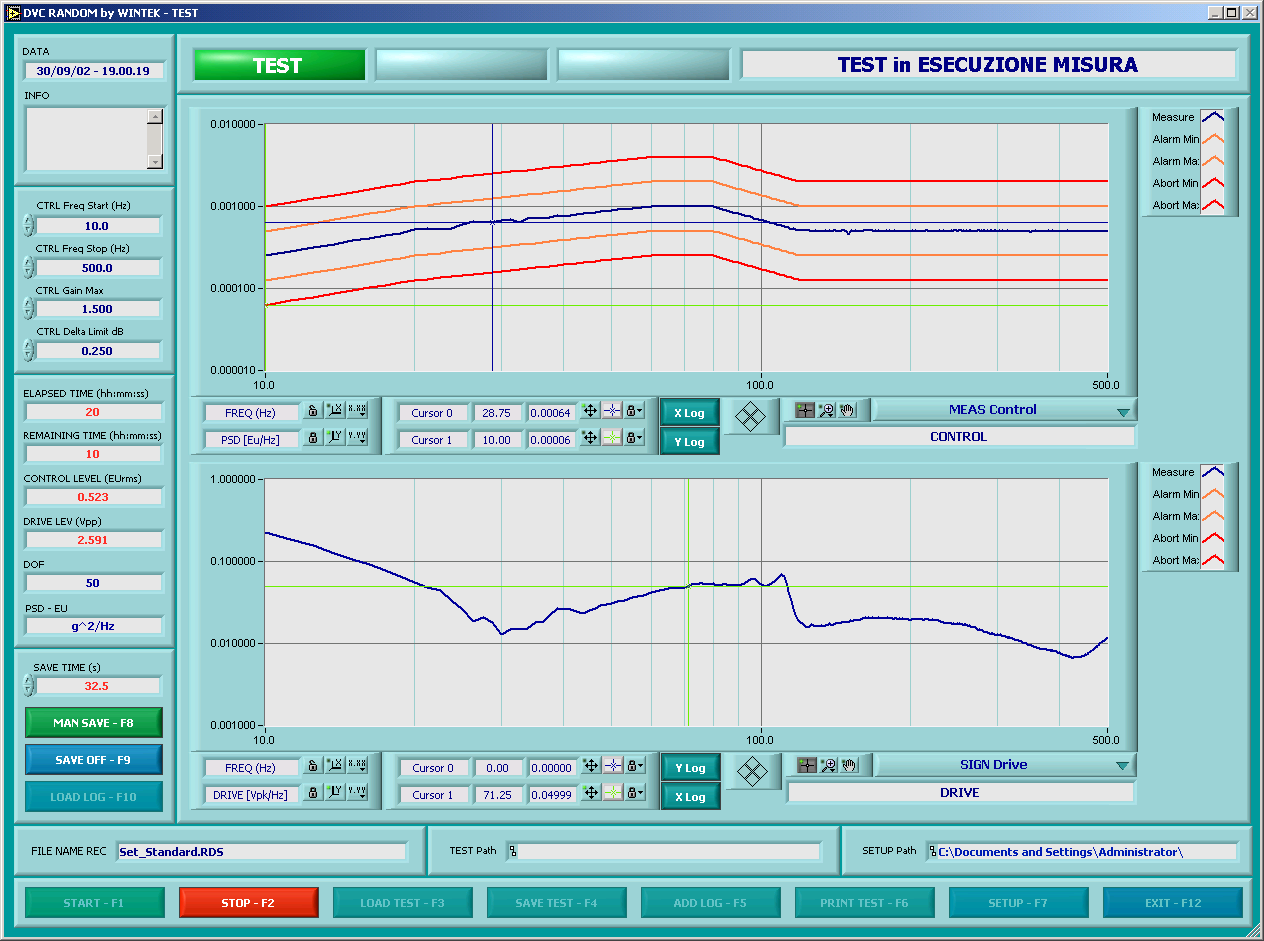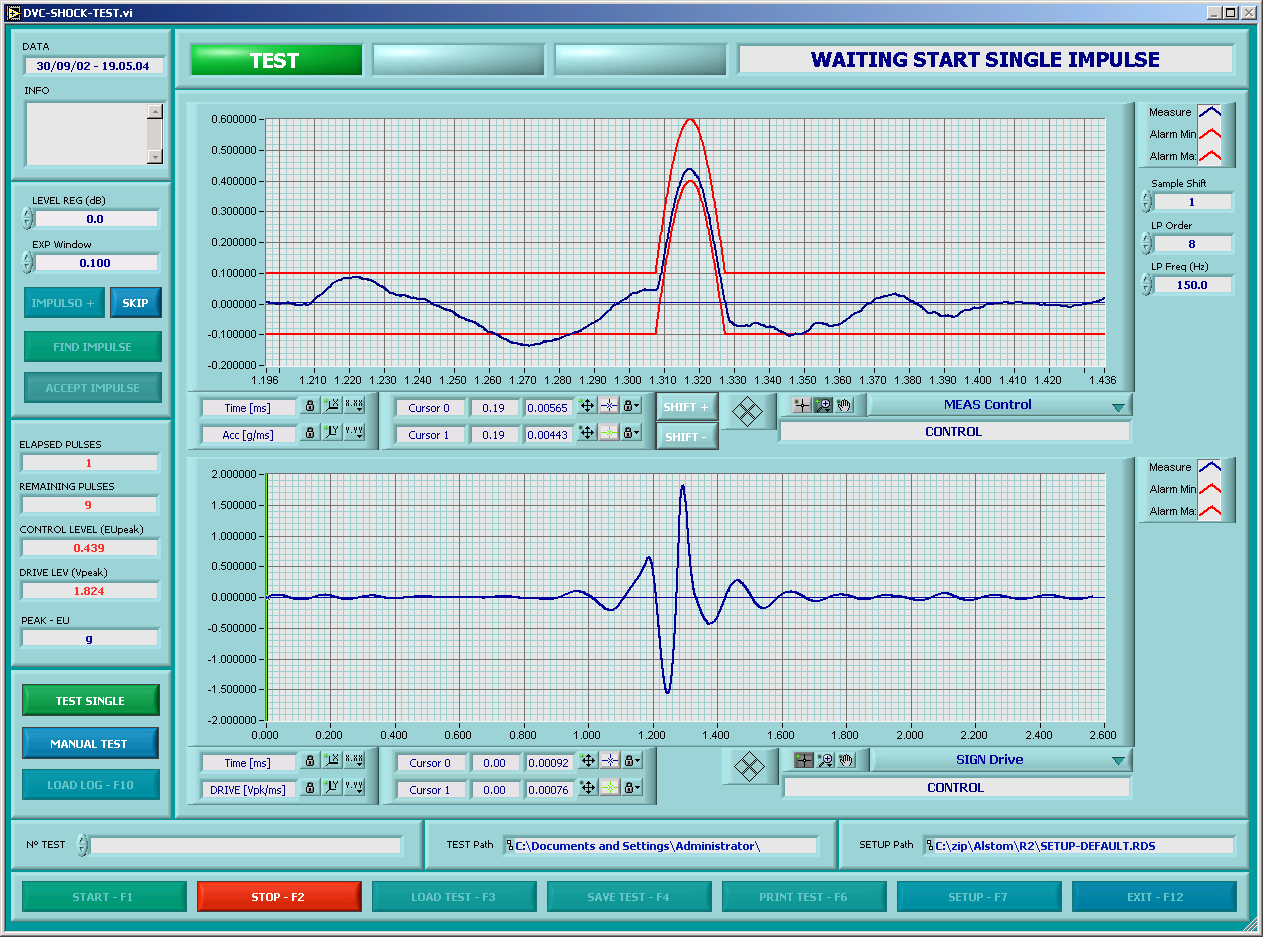Digital Vibration Controller
Control System for Vibrating Tables of different types in SINE, RANDOM, and SHOCK modes.
The Digital Vibration Controller (DVC) is a PC-based system designed to control various types of vibration testing systems in SINE, RANDOM, and SHOCK modes. It offers flexibility, high performance, and ease of use, adapting to a wide range of testing needs.
-
The software offers a wide range of advanced features, suitable for different vibration testing modes:
SINE Mode: Allows testing over a frequency range from 2 to 2000 Hz, with a dynamic range greater than 80 dB and a frequency resolution of 0.1 Hz. It includes linear and logarithmic sweep types, customizable test profiles, and an accuracy of ±1 dB. The display includes time and frequency domains, with zoom functions and measurement sliders.
RANDOM Mode: Enables testing with spectral resolution up to 12,800 lines and selectable ΔF resolution starting from 0.25 Hz. The dynamic range is greater than 70 dB, with typical loop times of 160 ms and accuracy similar to the SINE mode. The display is similar to that of the SINE mode, with adjustable scales.
Classic Shock Mode: Ideal for impact testing, supporting frequencies from 2 to 2000 Hz, with user-configurable low-pass filters, customizable pulse delays, and durations. The display follows the same standard as the other modes.
In addition to the specific features of each mode, the software integrates standard functions that make it highly versatile. These include the setup module, which allows for accurate management of limits, measurement units, and transducer sensitivity. Measurement capabilities include advanced tools such as oscilloscopes, FFT analyzers, and detailed time history. Reporting allows test data to be saved and exported in TXT format for further analysis or sharing.
-
The DVC features a flexible and highly customizable architecture that combines hardware and software components to ensure optimal performance.
Hardware
The hardware is designed to meet the specific needs of testing. It includes a control board integrated into the PC platform, an external box for signal connection and conditioning, and options for performance expansion. The configuration is user-definable, with connectivity for pre-conditioned ICP or piezoelectric sensors, a customizable front-end with up to 8 channels, and advanced sampling (multiplexed or simultaneous) with 12 to 24-bit A/D converters.
Software
The modular software, developed in LabVIEW for Windows, offers intuitive programming and supports test modes such as SINE, RANDOM, and SHOCK. The configuration can be customized to meet specific testing needs, generate automatic reports, and utilize a simple user interface for quick test setup.
-
The DVC is used in various industrial sectors, including:
Aerospace: For testing components and structures subjected to intense vibrations.
Automotive: Control and certification of parts exposed to mechanical stresses.
Electronics: Testing the resistance of electronic devices to vibrations and shocks.
Energy: Testing turbines, generators, and other components subjected to vibrations.
Defense: Simulations of extreme conditions for equipment and instruments.
Manufacturing: Validation and quality control on production lines.
-
16/18bit Configuration
Main Components: NI-PCI Eseries/Mseries boards.
Signal Box: Compact, BNC connections, shielded multi-conductor cable.
Analog Inputs:
8 differential channels.
Sampling: Multiplexed at 333 kS/s.
A/D Resolution: 16/18 bits.
SNR: >85 dB typical.
Analog Outputs:
2 channels: 1 for drive control, 1 for phase reference.
A/D Resolution: 16 bits.
24bit Configuration
Main Components: NI PCI 4472 (inputs) and NI PCI 4451 (outputs) boards.
Analog Inputs:
8 differential channels with simultaneous sampling.
Sampling Frequency: 102.4 kS/s.
A/D Resolution: 24 bits.
NR: 120 dB typical.
Analog Outputs:
2 channels: Similar to the 16/18-bit configuration.
A/D Resolution: 16/24 bits.


